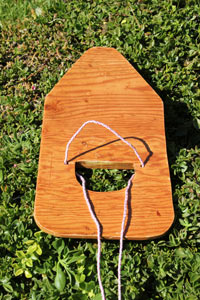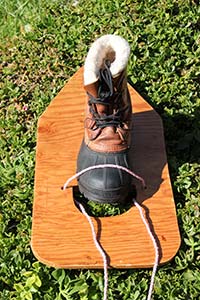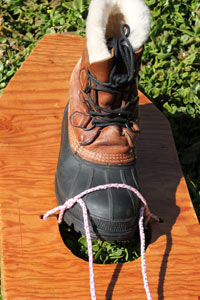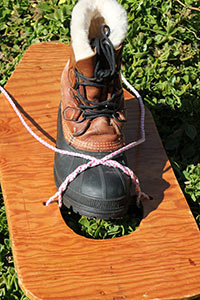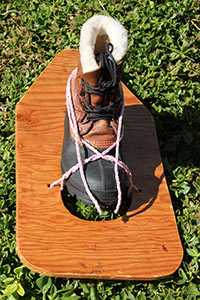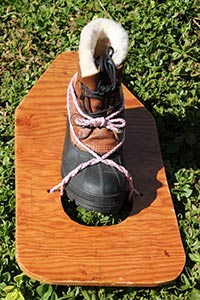
Events
Events Links
Direction Finding/Navigation
- Astronomy: Knowledge of the heavens
- Find Your Gold Claim: Map and compass skills
- Compass Bearing: Compass Skills
- Spanning the Stream/Height and Distance Estimation: Estimation
Fire Build and Axemanship
- Winter Survival Fire Lighting: Fire Building
- Ax Accuracy: Ax skills
First Aid
- The Injured Cheechako: General First Aid Skills
Knots/Lashing
- Tie Up the Dogs: Knot Tying
- Out-of-Reach Essential Gear: Lashing or Rope Skills
- Temporary Cache/Bear Bag: Ropes and Knots
- River Cross/Rope: Rope Work
Team Building
- Tarp Toss: Coordination
- Cliff Climb: Team Work
- Jumbo Ski: Team Work
- Ice Rescue: Team Work Ropes and Knots
- Blizzard Hid the Cabin: Individual Initiative
- Snow Blind Camp Find: Cooperative Leadership
- Thule Valley Fog: Leadership
- The Injured Scout: Leadership
- White Out / Blind Dog Trail Run: Leadership
Integrated Skills
Just for Fun
- Statue of Liberty Sled Race: Novelty Sled Race
- Moose Hunt/Spear Throw
- Tobacco Spit
- Snow Ball Throw
- Ptarmigan Shoot: Slingshots
- Snow Snake Throw: Board Casting
- Ice Snapper Fishing: Catching Mousetraps
- The Don't-Spill-the-Serum Race: Novelty Sled Race
- Snowshoe Race
Venturers and Senior Scouts
- Dead Horse Drag: Z-rigs, Rope Work, Team Work
- Hasty Snow Shelter: Shelter Building, Team Work
Standard Dog Team Commands
The choice of events is strongly driven by the weather, the environment, the skill of staff, and the experience, age, and skill of the participants. There are about 30 events described below which, with variations, give you more than 40 choices. To make more interesting, or challenging, events it is also possible to combine events into an integrated problem. An extreme example would be to navigate to a "river crossing", rig a crossing rope, scale the bank with a lashed ladder, find a lost miner, make him tea over a wood fire, perform first aid, and transport him back. Combined events are especially good for Ventures and Senior Scouts. On the other hand if you have WEBLOS participating you may want to remove elements to make an easier event.
Although these events are broken out by category, you should note that many could easily fit in multiple categories. Try to select events from a spectrum of types and never forget that the story is as important to event satisfaction as the actual skill. Spit as far as you can has no sparkle. The fact that there is a bar in Alaska which still had, in 1972, a record tobacco spit line that was over thirty feet adds color. The question is, how close can you come to spitting this licorice gob to that thirty foot record? Now that makes the event something...
Direction Finding/Navigation
Astronomy:
The team is offered the opportunity to identify objects in the sky. One point is given for each object (and collection of objects) correctly identified. Objects may be moons, planets, stars, star clusters, constellations, asterisms. Any correct name may be given (eg. Big Dipper = Plough = Big Bear = Ursa Major). If the team knows the difference between an asterism (eg. Big Dipper) and the constellation (Ursa Major) they can earn one point for each. Two points are given for each correct method that they can describe for finding directions in the night sky without a compass.
Find Your Gold Claim:
The patrol demonstrates map and compass skills as follows. Using a compass they orient a map to true North. When they have satisfied the judge, they determine the bearings of two lines laid on the map. When they have these correct to within five degrees they are given a route through five check points (orange cones each marked with a topo map symbol) which they follow using compass bearings. They record the symbols in the order seen to prove that they followed the route correctly. Time is added for each symbol out of order. This is a timed event.
Compass Bearing:
All members of the patrol sight on three objects and report individually on their bearings. Each degree of error earns one point. (Errors of more than twenty degrees should generate a ten point penalty, some advice, and an opportunity to try again). Then each patrol member is given a bearing which is correct for one of an arc of wands which are two degrees apart. Each error of one wand left or right of the true target earns one point. All patrol member scores are added up and divided by the number of people in the patrol. Low score wins. Members are encouraged to help each other.
Spanning the Stream/Height and Distance Estimation:
When traveling in winter there are times when one needs to fell a tree in order to make a dry crossing of a stream. To do this one needs to be able to tell how wide the stream is and how tall the tree is. Using whatever method they like the patrol needs to estimate the height of a tree and the width of a simulated stream (the distance between two poles). They are not allowed to touch the tree and they are not allowed to cross an imaginary shoreline running perpendicular to the line between the poles. One point is scored for each foot of error. Low score wins. It should be clearly established in the rules if it will be forbidden to use a ruler, compass or protractor for this event. If it is allowed it can either be specifically allowed or implicitly allowed.
Fire Build and Axemanship
Winter Survival Fire Lighting and X, where X is a Task
The patrol needs to lay and light a fire and accomplish a task. In order of difficulty the tasks are: burn a string, boil water, melt snow and boil water, and hard boil an egg. Fire wood may be provided in a form ready to use, or more difficult, the patrol is given/allowed two one foot 2x4s and an ax. Tinder may be provided or the patrol needs to bring its own. Liquid fire starters should be forbidden. The use of cotton balls (with petroleum jelly?) should be encouraged. The use of burnable food stuffs should be encouraged (corn chips, potato chips etc.) The fire should be built in a fire pan. For extra challenge the fire pan should have an inch or so of snow in it which the patrol is not allowed to remove. This is a timed event.
Ax Accuracy:
Using the ax provided, the team will attempt, using a full swing (ax head starting above the shoulders), to split match sticks standing vertically in a log, block or stump. Each player takes five tries. One point is scored for each match split. Two points are scored for each match lit (if "strike anywhere" matches are used). Max score per player is 10. Patrol score is the average of the individual scores.
First Aid
The Injured Cheechako:
Scouts must figure out what condition has stricken a victim and provide correct treatment. This can be as elaborate as the weather, equipment, and likely skill level of participants allow. Points are scored for successful diagnosis and proper treatment.
Knots/Lashing
Tie Up the Dogs:
Sled dogs will fight to the death if not kept apart. In this event we tie up the dogs for the night in a very particular way. A tie line is strung between two trees or posts and each dog is tied to the tie line with a dog line. The tie line is attached to one post with a Timber Hitch and to the other post with a Clove Hitch. Each dog line consists of two short lines. One short line is attached to the tie line with Two Half Hitches (in the form of a Clove Hitch around the tie line). The other short line is attached to the dog with a Bowline Loop. The two short lines are connected with a Sheet Bend. Slip versions of all these knots are allowed. The event starts with all the lines on the ground made up the way the patrol desires except that no two lines may be in Contact with each other. The event ends with the lines made up the way the patrol had them at the start. This is a timed event. The clock will stop for knot inspection when all the dogs are tied in. If issues exist, the judges will point out all deficient knots and restart the clock. The clock will stop again for inspection when the dogs are believed tied in properly. When they are all properly tied the clock will resume for the tear down. Time ends when all lines are in the end position.
Out-of-Reach Essential Gear:
Essential equipment lies just 9 feet away in the ice cold stream. You can't walk over to it because you will get wet and freeze to death. Instead, patrols must use pioneering skills to create a device to retrieve the kit while staying dry. In a pure rope event this has been set up so that the device could be retrieved by making a Running Bowline (or other slip noose) and lassoing the gear. It has also been set up for heaving lines with grappling hooks. For a lashing approach it is common to provide some 5 to 8 foot spars and enough rope to create a long enough pole. Another lashing approach provides three 8 foot spars and three 4 foot spars and enough rope to lash together a "bridge" that will take a scout out to the gear (a possible obvious solution being an A frame trestle lashed on the end of two 8 foot spars to form a dock which is dropped in place). This is a timed event.
Temporary Cache/Bear Bag:
A ten to twenty pound pack is suspended from a branch so bears can not steal it during the night. The bag must be at least 12 feet (4m) above ground, 10 feet (3 m) away from tree, 3 feet (1 m) below any branches, and the rope must be against tree trunk until at least 10 feet (3 m) above ground. Variation, two ten pound packs are counter balanced a minimum of 10 feet (3 m) off the ground. Timed event. All knots must be from either the BSA Handbook or Pioneering MB Book.
River Cross/Rope:
A 12 foot wide icy stream must be crossed without getting wet and potentially freezing to death. A foot rope and hand rope(s) are rigged between suitable posts or trees and the patrol crosses the stream using the ropes (think stripped down monkey bridge). For a more challenging event they must also get their sled and gear across. The first person to cross must also cross the stream without touching the water (snow). Timed event. This was a common stream crossing technique during the Alaska and Yukon Gold Rushes.
For skilled Venturers and Senior Patrols reduce the width to 10 feet and provide 3 or 4 eight foot spars and extra rope. This was a team problem solving task in some Commando schools. Think Shear Lashing two poles together with the pole butts about 2 feet apart with a tie line. Tie stabilizer lines (foot and hand ropes)to the top of the Shears. Put the butts of the Shears as far out in the stream as possible. Put a member in the top of the Shears. Use spars to push the Shears to the vertical and beyond controlling the Shears with the guide lines. Drop member on the far bank with dry feet. QED. Thoughtfully rigged, the foot and hand lines can be recovered without going back for them. If they foul or there is not enough line, the last man is recovered using the Shears.
Team Building
Tarp Toss:
Using a small tarp, a tennis ball (gold nugget) is tossed over a horizontal rope about ten feet (3 m) in the air. The patrol is given five minutes. For each time the ball passes over (crosses) the rope two points are awarded. For each time the ball is handled by hand (eg. picked up off the ground and placed on the tarp) one point is deducted. It is allowed to scoop the ball out of the snow with the edge of the tarp with no penalty. Whenever a toss is being made at least four patrol members must be in Contact with the tarp. After every ten tosses, idle patrol members must be substituted for active ones. Every patrol member must participate in at least ten tosses or incur a ten point penalty. Negative scores are allowed. High score wins.
Cliff Climb:
In the Yukon stream banks were often too steep and slippery to climb. The answer was to build a ladder to assist. Using ropes and two 8 foot and four 2 foot spars provided, the patrol must lash together a scaling ladder and use it to climb to the top of a short (~6 foot) cliff. This is a timed event. To make the event more challenging they could be required to drag their sleds up as well (with all their gear). A different wrinkle, if the terrain allows, would be for them to have to scale a ~12 foot rise in two stages by pulling up the ladder behind them. The bank need not be a cliff and for a two stage should not be a cliff. It just needs to be steep enough that it can not be readily climbed without assistance. The difficulty can also be changed by varying the amount of rope available for stabilizing and raising the ladder.
Jumbo Ski:
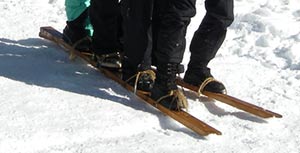 The snow can be too soft to walk on but spreading your weight helps. Here we are going to improvise some snowshoe/skis and walk the patrol together across the snow. There are three variations on this event. In all of them 8 foot 2x4s or 2x6s are used as skis to walk a course on easy ground involving at least one tight turn. The length of the course depends a great deal on the weather and terrain and on the age of the participants. Each ski is angle cut at the head and rigged with four attachment points. It is a timed event. In the first variation short lines are rigged to the attachment points and each participant (4 total) ties their feet, one to each ski, into the "binding". This tie in can be simple across toe loops or something like a "Lampwick" snowshoe binding (patrol's choice?). The patrol then shuffles the ski along by coordinating the motions of their feet. In the second (harder) variation two 4 foot ropes are attached, one on each side of the ski, at each attachment point. Patrol members stand on the skis at the attachment points and move the skis by alternately lifting them with the ropes, pushing them forward with their feet, and then lowering them. In the third (hardest) variation there is one rope at each attachment point and they alternate sides going down the ski (the first set being on the right side of both left and right skis, the second set being on the left side of both left and right skis, and so on). Movement is like the second variation except each member only controls the lift on one side of the ski and a higher level of coordination is required. In a variation on all the variations, there is no turn. Ski forward to the mark. Ski backward to the finish.
The snow can be too soft to walk on but spreading your weight helps. Here we are going to improvise some snowshoe/skis and walk the patrol together across the snow. There are three variations on this event. In all of them 8 foot 2x4s or 2x6s are used as skis to walk a course on easy ground involving at least one tight turn. The length of the course depends a great deal on the weather and terrain and on the age of the participants. Each ski is angle cut at the head and rigged with four attachment points. It is a timed event. In the first variation short lines are rigged to the attachment points and each participant (4 total) ties their feet, one to each ski, into the "binding". This tie in can be simple across toe loops or something like a "Lampwick" snowshoe binding (patrol's choice?). The patrol then shuffles the ski along by coordinating the motions of their feet. In the second (harder) variation two 4 foot ropes are attached, one on each side of the ski, at each attachment point. Patrol members stand on the skis at the attachment points and move the skis by alternately lifting them with the ropes, pushing them forward with their feet, and then lowering them. In the third (hardest) variation there is one rope at each attachment point and they alternate sides going down the ski (the first set being on the right side of both left and right skis, the second set being on the left side of both left and right skis, and so on). Movement is like the second variation except each member only controls the lift on one side of the ski and a higher level of coordination is required. In a variation on all the variations, there is no turn. Ski forward to the mark. Ski backward to the finish.
Ice Rescue:
This event is timed and simulates an Ice Rescue. One patrol member becomes the victim and is staged on an object (tub sled, saucer, inner tube) about 20 feet from the "shoreline". The patrol is on shore with two 15 foot lines. They may make up these lines any way they wish before the event starts. On the start signal they join the two lines together with a single or double sheet bend and heave the line to the victim. The victim places a loop of the line around their body (the loop formed with a bowline) and are dragged to shore. The line must pass close enough to the victim that they can recover it without placing weight on the snow. For WEBLOS the sheet bends could be omitted and the distance reduced. For the score to count both knots must be correctly tied.
Blizzard Hid the Cabin:
You were out collecting wood when a sudden Williwaw blew up so much snow you could not see the cabin or anything else except the snow at your feet, Your job is to find the cabin before the cold wind kills you. The cabin is marked by a pole in the snow. Each player is escorted to a start point about 30 feet from the pole. They are given one minute to study the ground and surroundings. Then a bucket is placed over their head and they are rotated two plus turns and left facing a random direction. They are not allowed to tilt the bucket back to see but are allowed to look down past the bucket rim. (One variant puts a snow ball on top the bucket and if it falls off they score 100 points). They are then given one minute to walk to the cabin. Their individual score is determined by how many feet they are from the pole at the end of time. The patrol score is an average of the individual scores. Low score wins. This can also be done letting each use a compass both during the view and the run.
Snow Blind Camp Find:
Rat Faced Harry, the meanest cuss in camp who will kill anyone who touches him, is suffering from snow blindness. Your job is to talk him from where he is to his cabin door. One patrol member is blindfolded and placed at the start mark. Two poles are set 3 feet apart at the finish as the door of the cabin. The rest of the patrol must guide Harry using words only. This is a timed event. For a harder variation, Harry is an Uzbeki musher who knows no English. He must be guided using only the Standard Dog Team Commands found below. For another variation the patrol leader is designated as Rat Faced Harry.
Thule Valley Fog:
You have run out of wood in your bunkhouse and you sent your patrol out to forage for wood. A Thule Fog has settled in the valley which is so thick you can not see your hand in front of your face. Your guys can not see to find their way back but you realize that from the food cache tower you can see the tops of their heads and the roof of the cabin. You must guide them in using verbal directions. Two poles are set 3 feet apart at the finish as the door of the cabin. The leader is 20 feet from the cabin door. The patrol members are blindfolded and started at different locations, all about 30 feet from the cabin door, all facing the cabin. Patrol members may move singly or all at the same time. This is a timed event. Elapsed time divided by the number of lost members (patrol total minus 1) is the patrol score. For more challenge the leader will use only the Standard Dog Team Commands found below.
The Injured Scout:
Blindfolded team members must carry one of their teammates on a hasty stretcher that they build through a marked course, relying solely on instructions from the Scout on the stretcher. This is a timed event. For a more challenging event the instructions to the stretcher team will use only the Standard Dog Team Commands found below.
White Out / Blind Dog Trail Run:
All team members except the "Musher" are blindfolded. The musher is at the end of a 10 to 15 foot line. Patrol members are spread on opposite sides of the line. The musher must guide the dogs through a marked course using verbal commands. For more challenge the musher will use only the Standard Dog Team Commands found below. This is a timed event. If patrols have similar sleds or one is provided this event can be run with sleds. This can also be done with the dogs and the musher blind and directions given by another member.
Integrated Skills
Search & Rescue Mission/Injured Miner Transport:
Over soft ground and snow, the travois was more reliable and more efficient than wheeled vehicles. In this event you are going to find and rescue an injured miner (a weighted duffle bag). To find him you will follow a compass bearing in a Bee Line until you discover the miner. You will use a travois that you have lashed together, along with a carry net, to transport the miner back to the start point. This is a timed event.
Just for Fun
Statue of Liberty Sled Race
This is a sled race with a twist. The rider must stand, and balance, on the sled while it is being pulled. No use of hands or arms for support is allowed (though arm waving for balance is allowed). Some people require that the hands stay above the shoulders. Depending on snow conditions this can be a short race around a circuit or a long race through an obstacle course (gentle hills). The race is timed. The penalty for the rider falling down (any body part but feet touching the sled) or off the sled is for the rider to run one lap around the stationary sled before the sled can continue. The typical sled is a tub sled with all patrols using the same sled. This could also be done with an unpadded toboggan. If event sleds are similar enough, Patrols could use their own sled. The most fun is for the entire Patrol to be involved. The fairest is to set the number of dogs at three or four.
Moose Hunt/Spear Throw:
Spears are thrown at a rope target suspended between poles or trees. The target has scoring areas which approximate the kill zone on a moose. Scores run from zero to five. Each patrol member throws two spears for practice and then two for score. If they throw a scoring spear with their practice spear they may take that score and throw once more for the other scoring throw. Each member can score from zero to ten points. Patrol score is the average of all the individual scores. Patrol score theoretically also ranges from zero to ten.
Tobacco Spit:
Tobacco spitting was a favorite contest for miners in both the Yukon and Alaska Gold Rushes. Considerable gold changed hands based on these contests. There were contests for accuracy (starting from how far away you could stand and still hit the spittoon) and distance. In this event patrol members do both. The accuracy spit is directed at a stake in the snow approximately three feet from the spit line. There are three rings around the stake at about six inch spacing. A hit on the stake is 5 points. The inner ring is 4 points. The next ring 3 and the outer ring 2. Any hit past the spit line is 1 point. The only way not to score is to not spit. The distance spit has a separate spit line. The outer line should be set by having a skilled adult spit their best and use that distance as the highest score line. Spits that hit or pass this line score 5. At intervals of 1 1/2 to 2 feet from this line additional lines are laid for 4, 3, and 2 points respectively. From the 2 point line to the spit line scores 1 point. The only way not to score is to not spit. An individual's score is made up of the accuracy spit plus the distance spit (best possible score is ten). Patrol score is the average of the individual scores. The "Chaw" for this event is a one to two inch chunk of black licorice per spit. Ideally this is chewed without swallowing until all the solids have dissolved leaving a black, viscous fluid. The scoring glob should count only liquids, never any solid chunks. The judge should determine where the main glob went and score accordingly.
Snow Ball Throw:
A target (perhaps a snow saucer or garbage can lid) is hung between two trees and stabilized so it neither swings nor rotates. Each player makes five snowballs and presents at the throw line. Each throws five snowballs and each hit counts as a point. The number of total hits divided by the number of patrol members is the patrol score. To make it a slightly different event hang the target by a single line and use another to swing it like a pendulum while the players throw. This is a great, no materials required, fill in for an event that does not show as even the target can be improvised (lines stamped in the snow on a hillside or a convenient tree or traffic sign).
Ptarmigan Shoot:
The Ptarmigan was an important food source in the Arctic and hunting them without guns saved shot and reduced the tendency of the birds to fly away. In this event the birds are paper or plastic plates (could be pie tins) suspended from tree branches or set on edge in the snow. Slingshots, using kibbled dog food (biodegradable and animal friendly so you do not feel guilty about the ones you do not find at cleanup) as pellets, will be used to hunt the Ptarmigan. The distance between the shooters and the birds should be based on conditions and player age and skill. (Take the most skilled adult shooter and see how far he can consistently hit the target. Use half that distance for the youth). Each player will get 5 or 10 shots and each hit will be a point. Adding up the total hits for the patrol and dividing by the number of patrol members gives the patrol score.
Snow Snake Throw:
This is an adaptation of a game attributed to the Seneca Indians. They probably played on lakes as they are reputed to have been able to slide their snakes over 1/4 mile. Their Snakes were carefully selected, shaped, smoothed and waxed or oiled small spars from 5 to 7 feet long. The track was made by dragging a smooth log to make a straight, smooth sided trench. When needed the trench was lightly sprinkled with water and allowed to freeze. For Scouts, Snakes can be made of clear furring strips that are cut to 4 to 5 feet, rounded at one end, smooth sanded and waxed or varnished (or both). The trench depends a great deal on the snow conditions and player skill. Using a 100 foot line to pull a 3-4 inch diameter spar hand over hand over level ground should make a suitable trench. Try dividing the trench into ten lengths and assigning 1 point for each length boundary crossed. Let each patrol member take the best score of two tries and average the patrol score.
Ice Snapper Fishing:
At its most trivial this is just a silly, fun event. The core idea is to "catch Ice Snappers" using a fishing pole. The fishing pole is any pole with a binder twine line and a large fender washer for bait. The ice snappers are old fashioned mouse traps. Drop the fender on the trigger and the Ice Snapper grabs on. The event difficulty can be changed by controlling the relationship between the length of the poles, the length of the line, and the distance to the Snappers. In the snow the traps can be set in foot holes where they can not be seen. To ramp up even further make every player tie on their own line and washer with specified knots. Another step up is to provide short poles and allow them to increase the pole length by doing Round Lashings. However the difficulty is set, scoring is typically done by allowing a fixed period for fishing and counting the number of Snappers caught.
The Don't-Spill-the-Serum Race:
Your basic sled race with one twist — there's a cup of liquid "medicine" (use water) sitting on top of the sled that can't be spilled during the race. This race should be run on easy ground with a short course with wide turns. This can be run as a timed or a head to head. A great way to do this is to use flat bottom, flat side, one cup plastic or metal measuring cups filled with 7 oz of water at the start and requiring at least 4 oz at the finish. Variations allow adding serum at checkpoints (typically requiring 4 oz to be present before add serum is offered).
Snowshoe Race:
A relay race while wearing snowshoes. At the start a patrol has two pairs of snow shoes. When the start signal is given they may put on the snowshoes. Patrol members may help each other put on and take off snowshoes except on the course where this help may only be provided with the judges permission. Each member of the patrol must travel a marked course while wearing the snowshoes. Only one member may be on the course at a time. If a binding or shoe breaks the clock is stopped until repairs are made. If a foot comes free because of loose bindings or player error, the player must fix the binding in place with the clock running. Total elapsed clock time divided by number of patrol members determines the team score. Low score wins.
Make your own plywood snowshoes:
Top View
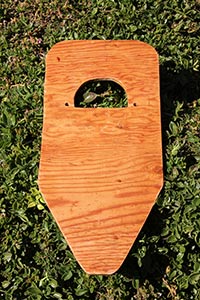
Bottom View
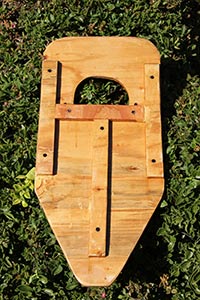
Venturers and Senior Scouts
Dead Horse Drag:
Your pack horse has died on the Dead Horse Trail out of Skagway and you need to get it off the trail. You have to work together as a patrol to package and drag the horse (a pair of weighted duffle bags) off the trail. The horse must be wrapped in a tarp and then a sling rigged around the tarp. A Z rig will be set up anchored to a rock or tree designated by a judge. The horse will then be dragged, using the Z rig, until the judge is satisfied that it is clear of the trail. The drag may not start until the judge clears the slings and the Z rig as correctly applied and safe. This is a timed event.
Hasty Snow Shelter:
It is 3:00 and getting dark. The temperature is below freezing and dropping. The winds are picking up. Using the tools and materials provided, and what is available from nature, you have 20 minutes to build a survival shelter appropriate to the conditions. This event can be structured for patrol size shelters or individual shelters or the patrol can choose which to do according to the needs of the contest. The event should be scored on points with an emphasis on resistance to wind and to providing insulation from cold.
Standard Dog Team Commands
- Hike, Mush, All Right - Start moving.
- Haw- Turn left ("Haw, like southpaw").
- Gee- Turn right ("Gee, that's right"). Pronounced "jee".
- Good- Keep doing what you're doing.
- Easy- Slow down, but keep moving. Don't let the rope go slack.
- Pick it up (or Kissing Sounds) - Go faster.
- Gee over- Move to the right side of the trail.
- Haw over- Move to the left side of the trail.
- On By- Keep going straight, passing other teams.
- Whoa- Stop.
